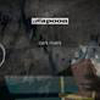 One of Robin Storey’s many strengths has been to the ability to translate the genius loci of his north England homeland into musical artifacts. Listening to Dark Rivers put me in a headspace of animistic communion with the internal and external landscapes he evokes. As the title suggests, they were mostly of an aquatic nature. These songs are fluid, amorphous, ever shifting, snaking like water from creek to river to ocean, and layered in time (spanning from monolithic rock glyphs to the military-industrial complex of the Cold War) as well as in space.
One of Robin Storey’s many strengths has been to the ability to translate the genius loci of his north England homeland into musical artifacts. Listening to Dark Rivers put me in a headspace of animistic communion with the internal and external landscapes he evokes. As the title suggests, they were mostly of an aquatic nature. These songs are fluid, amorphous, ever shifting, snaking like water from creek to river to ocean, and layered in time (spanning from monolithic rock glyphs to the military-industrial complex of the Cold War) as well as in space.
The sampled voice of Terrence Mckenna, unmistakable with its hyperspace insectoid drawl, opens the record with the time stretched utterance “something on the edge of nowhere,” announcing the liminal passages and secretive undercurrents explored on this album. Mckenna’s words encapsulate the fleeting feeling of trying to capture fugitive thoughts and images as they pass, rapid fire, through the cobwebs of the mind—the same subconscious places these songs seem to seep into and probe. Illegible voices from a police or military scanner emanate from swirling pools of reverb laden percussion, full of squelch, each one squabbling for supremacy.
“Old Gods and Freezing Rain” is a piece filled with dark echoing screams that conjure up visions of tribal warfare, sacrifice, and invocation. The rhythmic palpitations and elongated loops of “After the Storm” clear the cold air after that hiss laden aberration. The lazy pitter-patter of soft snares and brushed hi-hats is reminiscent of a slow drizzle. A few notes are played on a synth, forming concentric circles that ripple out of the stereo in a moment of transcendent beauty. Lush synth chords are also present on “The Messiah of Science,” but they are buried underneath relentless distorted rhythms. The aggression heard there is quick to abate though as “Particle Dome” mixes the calm evening chirps of crickets with detuned chanting, and a vaporous sound bringing to mind images of fog and mist rolling into the hills. The drones continue in “This Side of Zero,” the longest track at 13 minutes and sandwiched smack dab in the middle. It percolates gently with voices sounding as if they have been slurred by a tape dragging at the wrong speed. Later the crackling of a stylus emerges processed with flange or phase. “Drawing Lines in the Rocks” is another luminary song. The percussion has been sped up to the point where it does not sound like separate hits or punctuations, transforming into a smooth accelerated tone, with shimmering middle-eastern strings weaving loom like around it, at a lower volume, just beneath the surface.
Dark Rivers is filled with many of Storey’s patented techniques, his idiosyncratic use of percussion and loops, and sounds culled from various unnamed world instruments. Landscapes, whether natural or altered by man (modern or ancient) are motifs he has explored on his other albums and in his visual artwork. As such this album is a further refinement of his aesthetics and working procedures, and a represented his continued deepening immersion in the environment around him.
samples:
Read More

